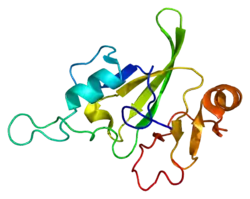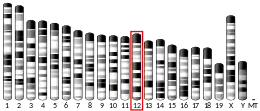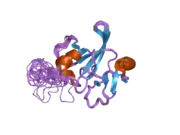HBP1
HMG-box transcription factor 1, also known as HBP1, is a human protein.[5]
Interactions
HBP1 has been shown to interact with SIN3A[6] and Retinoblastoma protein.[7]
References
- ENSG00000283847 GRCh38: Ensembl release 89: ENSG00000105856, ENSG00000283847 - Ensembl, May 2017
- GRCm38: Ensembl release 89: ENSMUSG00000002996 - Ensembl, May 2017
- "Human PubMed Reference:". National Center for Biotechnology Information, U.S. National Library of Medicine.
- "Mouse PubMed Reference:". National Center for Biotechnology Information, U.S. National Library of Medicine.
- "Entrez Gene: HBP1 HMG-box transcription factor 1".
- Swanson, Kurt A; Knoepfler Paul S; Huang Kai; Kang Richard S; Cowley Shaun M; Laherty Carol D; Eisenman Robert N; Radhakrishnan Ishwar (Aug 2004). "HBP1 and Mad1 repressors bind the Sin3 corepressor PAH2 domain with opposite helical orientations". Nat. Struct. Mol. Biol. 11 (8): 738–46. doi:10.1038/nsmb798. ISSN 1545-9993. PMID 15235594. S2CID 44324333.
- Lavender, P; Vandel L; Bannister A J; Kouzarides T (Jun 1997). "The HMG-box transcription factor HBP1 is targeted by the pocket proteins and E1A". Oncogene. 14 (22): 2721–8. doi:10.1038/sj.onc.1201243. ISSN 0950-9232. PMID 9178770.
Further reading
- Tevosian SG, Shih HH, Mendelson KG, et al. (1997). "HBP1: a HMG box transcriptional repressor that is targeted by the retinoblastoma family". Genes Dev. 11 (3): 383–96. doi:10.1101/gad.11.3.383. PMID 9030690.
- Lavender P, Vandel L, Bannister AJ, Kouzarides T (1997). "The HMG-box transcription factor HBP1 is targeted by the pocket proteins and E1A". Oncogene. 14 (22): 2721–8. doi:10.1038/sj.onc.1201243. PMID 9178770.
- Zhuma T, Tyrrell R, Sekkali B, et al. (2000). "Human HMG box transcription factor HBP1: a role in hCD2 LCR function". EMBO J. 18 (22): 6396–406. doi:10.1093/emboj/18.22.6396. PMC 1171702. PMID 10562551.
- Lemercier C, Duncliffe K, Boibessot I, et al. (2000). "Involvement of Retinoblastoma Protein and HBP1 in Histone H10 Gene Expression". Mol. Cell. Biol. 20 (18): 6627–37. doi:10.1128/MCB.20.18.6627-6637.2000. PMC 86159. PMID 10958660.
- Shih HH, Xiu M, Berasi SP, et al. (2001). "HMG Box Transcriptional Repressor HBP1 Maintains a Proliferation Barrier in Differentiated Liver Tissue". Mol. Cell. Biol. 21 (17): 5723–32. doi:10.1128/MCB.21.17.5723-5732.2001. PMC 87292. PMID 11486012.
- Sampson EM, Haque ZK, Ku MC, et al. (2001). "Negative regulation of the Wnt–β-catenin pathway by the transcriptional repressor HBP1". EMBO J. 20 (16): 4500–11. doi:10.1093/emboj/20.16.4500. PMC 125566. PMID 11500377.
- Strausberg RL, Feingold EA, Grouse LH, et al. (2003). "Generation and initial analysis of more than 15,000 full-length human and mouse cDNA sequences". Proc. Natl. Acad. Sci. U.S.A. 99 (26): 16899–903. Bibcode:2002PNAS...9916899M. doi:10.1073/pnas.242603899. PMC 139241. PMID 12477932.
- Hillier LW, Fulton RS, Fulton LA, et al. (2003). "The DNA sequence of human chromosome 7". Nature. 424 (6945): 157–64. Bibcode:2003Natur.424..157H. doi:10.1038/nature01782. PMID 12853948.
- Ota T, Suzuki Y, Nishikawa T, et al. (2004). "Complete sequencing and characterization of 21,243 full-length human cDNAs". Nat. Genet. 36 (1): 40–5. doi:10.1038/ng1285. PMID 14702039.
- de Chiara C, Kelly G, Frenkiel TA, Pastore A (2004). "Assignment of the 1H, 13C, and 15N resonances of the AXH domain of the transcription factor HBP1". J. Biomol. NMR. 28 (4): 411–2. doi:10.1023/B:JNMR.0000015367.92295.0f. PMID 14872137. S2CID 43367627.
- Berasi SP, Xiu M, Yee AS, Paulson KE (2004). "HBP1 Repression of the p47phox Gene: Cell Cycle Regulation via the NADPH Oxidase". Mol. Cell. Biol. 24 (7): 3011–24. doi:10.1128/MCB.24.7.3011-3024.2004. PMC 371097. PMID 15024088.
- Colland F, Jacq X, Trouplin V, et al. (2004). "Functional Proteomics Mapping of a Human Signaling Pathway". Genome Res. 14 (7): 1324–32. doi:10.1101/gr.2334104. PMC 442148. PMID 15231748.
- Swanson KA, Knoepfler PS, Huang K, et al. (2004). "HBP1 and Mad1 repressors bind the Sin3 corepressor PAH2 domain with opposite helical orientations". Nat. Struct. Mol. Biol. 11 (8): 738–46. doi:10.1038/nsmb798. PMID 15235594. S2CID 44324333.
- Gerhard DS, Wagner L, Feingold EA, et al. (2004). "The Status, Quality, and Expansion of the NIH Full-Length cDNA Project: The Mammalian Gene Collection (MGC)". Genome Res. 14 (10B): 2121–7. doi:10.1101/gr.2596504. PMC 528928. PMID 15489334.
- Yao CJ, Works K, Romagnoli PA, Austin GE (2005). "Effects of overexpression of HBP1 upon growth and differentiation of leukemic myeloid cells". Leukemia. 19 (11): 1958–68. doi:10.1038/sj.leu.2403918. PMID 16179914.
- Rual JF, Venkatesan K, Hao T, et al. (2005). "Towards a proteome-scale map of the human protein–protein interaction network". Nature. 437 (7062): 1173–8. Bibcode:2005Natur.437.1173R. doi:10.1038/nature04209. PMID 16189514. S2CID 4427026.
- Sekkali B, Szabat E, Ktistaki E, et al. (2005). "Human high mobility group box transcription factor 1 affects thymocyte development and transgene variegation". J. Immunol. 175 (8): 5203–12. doi:10.4049/jimmunol.175.8.5203. PMID 16210625.
- Kim J, Zhang X, Rieger-Christ KM, et al. (2006). "Suppression of Wnt signaling by the green tea compound (-)-epigallocatechin 3-gallate (EGCG) in invasive breast cancer cells. Requirement of the transcriptional repressor HBP1". J. Biol. Chem. 281 (16): 10865–75. doi:10.1074/jbc.M513378200. PMID 16495219.
- Lim J, Hao T, Shaw C, et al. (2006). "A protein–protein interaction network for human inherited ataxias and disorders of Purkinje cell degeneration". Cell. 125 (4): 801–14. doi:10.1016/j.cell.2006.03.032. PMID 16713569. S2CID 13709685.
- Zhang X, Kim J, Ruthazer R, et al. (2007). "The HBP1 Transcriptional Repressor Participates in RAS-Induced Premature Senescence". Mol. Cell. Biol. 26 (22): 8252–66. doi:10.1128/MCB.00604-06. PMC 1636767. PMID 16966377.
External links
- HBP1+protein,+human at the US National Library of Medicine Medical Subject Headings (MeSH)
This article is issued from Wikipedia. The text is licensed under Creative Commons - Attribution - Sharealike. Additional terms may apply for the media files.






